_We may earn revenue from the products available on this page and participate in affiliate programs. Learn more ›
_
Best Titanium
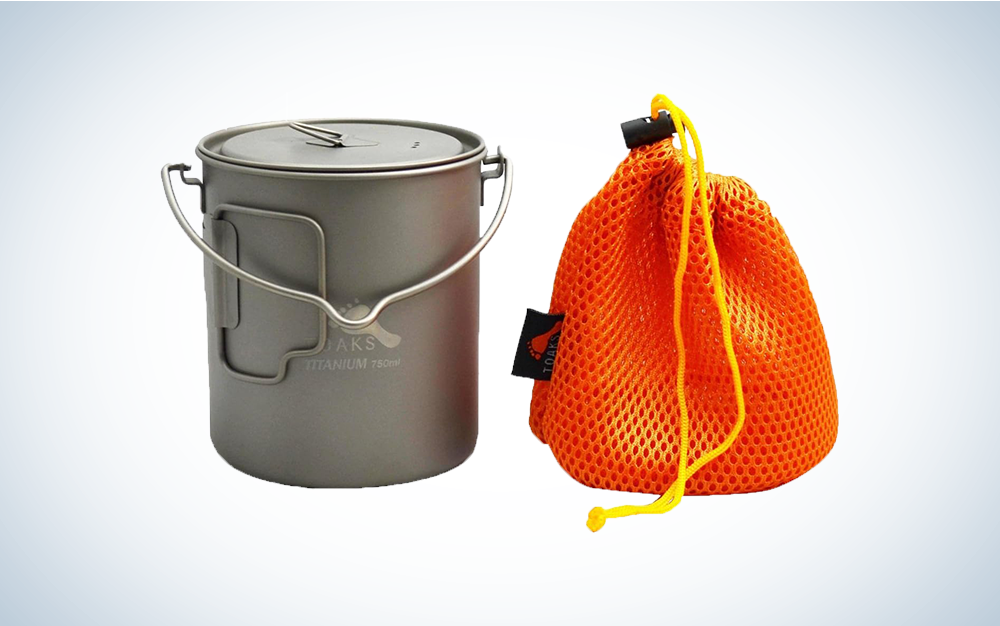
Toaks Titanium 750ml Pot with Handle
Best for Backpacking
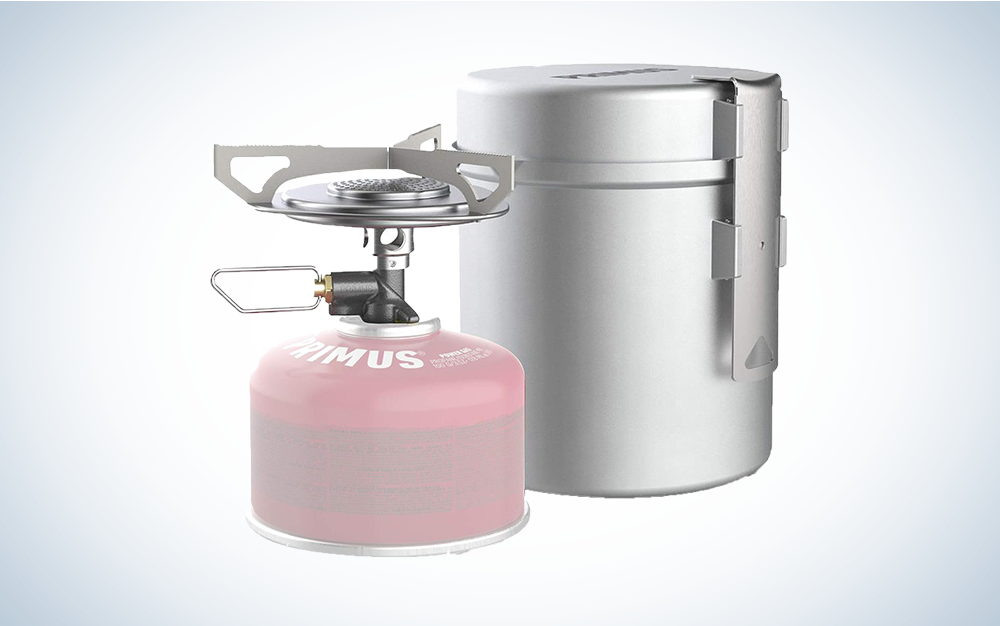
Primus Essential Trails Kit
Best Cast Iron
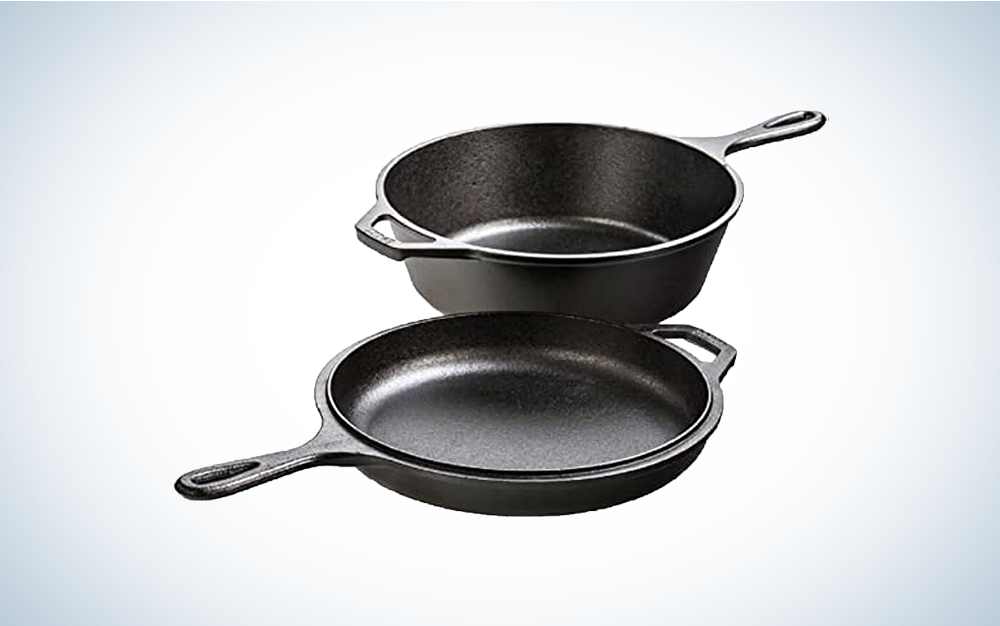
Lodge Cast Iron Combo Cooker
Let’s talk pots and plans, that is, camping cookware. Less praised than other pieces of camping gear, cookware is essential for any overnight trip into the woods. And with the exception of cold soakers, the quality of your pots and pans can make or break your expedition experience. Regardless of your approach to backcountry food—the sufferfest, the moveable feast, and everything in between—calories are some of the most important things you pack. Both physically and psychologically.
On every one of my trips, it doesn’t take long for trail talk to devolve into favorite meals. No one is going to be able to get you a Culver’s burger and battered cheese curds, but the right pots and pans paired with the right menu choice can keep that conversation wistful instead of mutinous. And at the end of the day, there’s nothing more celebratory than gathering around a fire with a good meal, conversation, and the opportunity to do it again in the morning. The best camping cookware will make your trip that much more enjoyable for all involved.
Best Overall: Fry-Bake Alpine Set
Best Titanium: Toaks Titanium 750ml Pot with Handle
Best for Backpacking: Primus Essential Trails Kit
Best Cast Iron: Lodge Cast Iron Combo Cooker
Best Heirloom Quality: Yeti 12” Cast Iron Skillet Set
Best Foldable: Sea to Summit X-Set 32
Best on a Budget: GSI Bugaboo Mess Kit
How We Picked the Best Camping Cookware
I care too much about food. In fact, I’ve been known to shoo others away from the stove and lay claim to all the cooking at camp. But I do let people help with the dishes. As the camp cook, I’m constantly cycling through a round of recipes and cookware in an attempt to find the best backcountry setup on the river or the trail. You’ll find me studiously testing pans, stoves, and recipes in the backyard before a trip deciding whether stainless steel, aluminum, cast iron, or titanium is the right choice for this next adventure.
I’ve used these cookware sets to saute freshly caught salmon
on remote Alaskan islands, cook up some mean breakfast tacos on the shores of Utah’s Green River, keep sand out of our oatmeal in Flagstaff’s high alpine desert, and rehydrate food in the pine forest of Michigan’s Upper Peninsula. Along the way, I’ve stumbled across some of the best (and worst) options out there. I’ve had some successes and plenty of wrong pot-for-the-job scenarios along the way, but these are the cook sets that stood out through my adventures.
Best Camping Cookware: Reviews & Recommendations
Best Overall: Fry-Bake Alpine Set
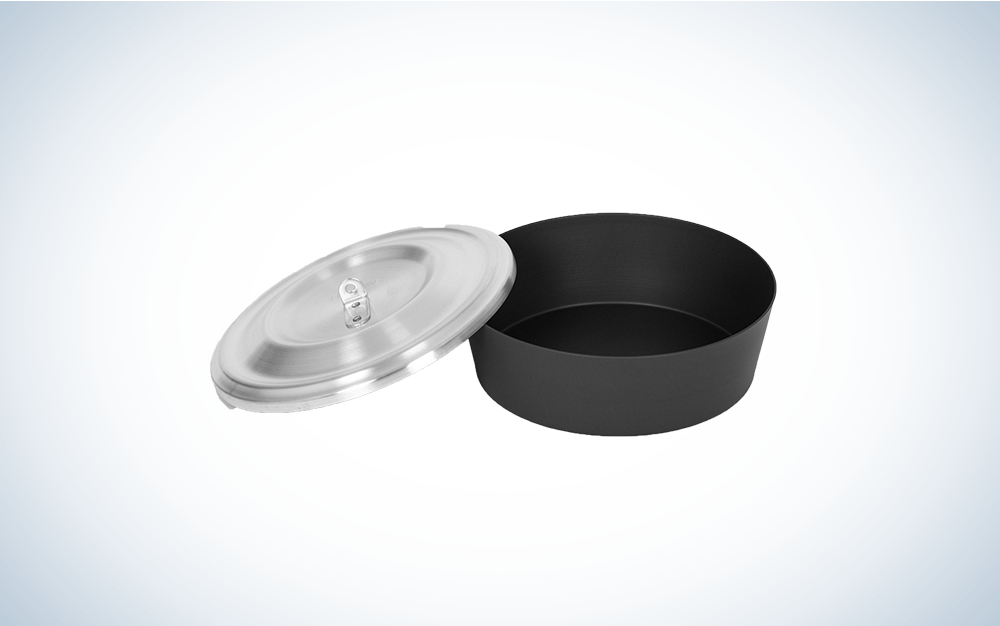
Specs
1 Alpine Pan
Materials: Aluminum w/ anodized hard coat
Diameter: 8 inches
Depth: 1 1/2 inches
Weight: Under 7 ounces and holds up to 3 cups (0.7 liters) when full
1 Deep Alpine pan
Materials: Aluminum w/ anodized hard coat
Diameter: 8 inches at the rim, 6 7/8 inches at the bottom
Depth: 2 1/4 inches
Weight: Under 8 ounces and holds 6 cups (1.4 liters) when full
1 Alpine Lid
Materials: Aluminum
Weight: Less than 5 oz.
Pros
Can be used with any cooking setup: fire, camp stove, embers
Easy to clean using rivers, stones, or sand
Lightweight and durable
Cons
Imperfect nesting capability
For our best overall category, a tricky metric of versatility and value was necessary. A set needs to be practical, durable, and capable—something that can endure whitewater and backpacking expeditions, but also useful for car camping. It needs to be able to cook over gas or wood, capable of boiling water for hot drinks, take on a hearty breakfast scramble, sear fresh trout filet, and top it off with a backcountry peach cobbler.
Pam Banks and her father solved this issue in 1979 when they produced the first round of Fry Bakes. The name is self-explanatory—these pots allow you to do everything from frying to baking. Built from aluminum with an anodized hard coat cooking surface, it’s essentially a backcountry dutch oven with the lightness of aluminum, the durability of cast iron, and the cooking range of non-stick. Plus, they’re a domestic production: every Fry Bake pan is made in New Hampshire, sent to Massachusetts for the hard anodized coating, and then brought back to New Hampshire, where Pam herself picks them up from the factory.
You can use metal utensils without scratching the surface, clean with pebbles or river sand, build a small twiggy fire on the lid for even baking, cook in your campfire coals, or on your camping stove. In short, this pan can take anything you throw on it. I’ve used mine to bake backcountry bread on an MSR Whisperlite, cook freshly caught salmon over a driftwood fire, and reduce wild blueberries into a syrupy jam. It produces culinary excellence every time. The Full Alpine set comes with a pan and a deeper pot, but if you need the whole hog, you can get the massive Expedition size, capable of feeding four or more.
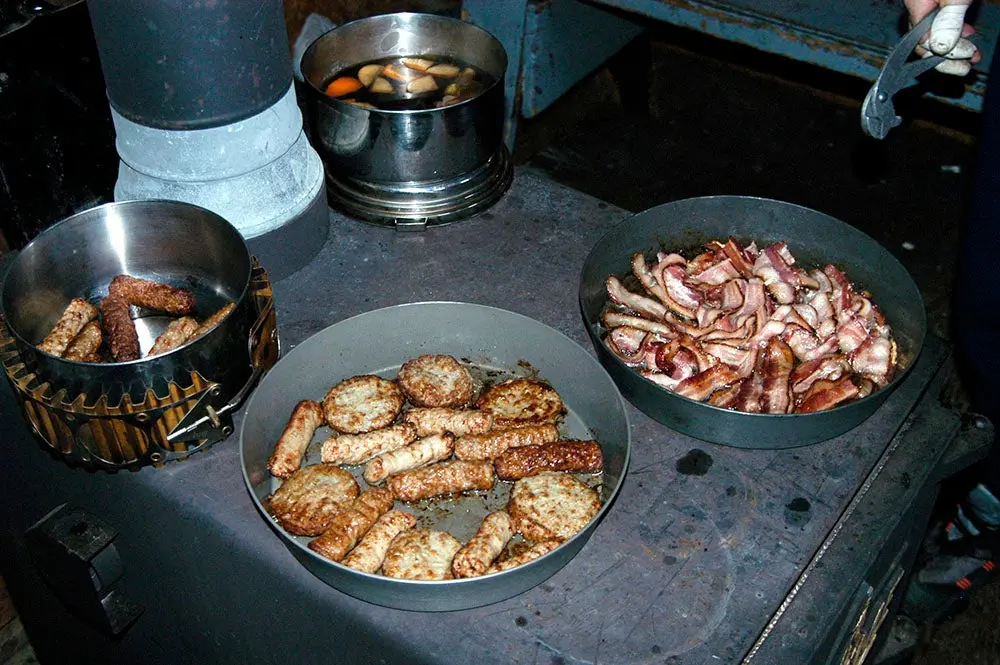
The Fry-Bake Alpine Set helps prepare breakfast. Fry-Bake
Best Titanium: Toaks Titanium 750ml Pot with Handle

Specs
Materials: Titanium
Weight: Pot only: 3.0 oz (86g), Pot with lid: 3.6 oz (103g)
Capacity: 750ml, 760ml if measured to the top of pot
Dimensions: Internal: 3 3/4″ (94mm) (Diameter) X 4 3/8″ (110mm) (H)
External: 102mm (Diameter) X 112mm (H) (measure with handles folded and lid on)
Pros
Extremely lightweight
Budget-friendly
Cons
The handle offers minimal heat protection
Some discoloration can occur over high heat
Toaks, a California brand with utilitarian leanings and steeply discounted prices, is the workman’s take on titanium cook sets. I’ve had a set of their single-walled mugs for years that have traveled around the world with me, invaluable not just for their lightness but also for their practicality. A single wall mug can take direct heat, thus taking the place of a pot on a camp stove when you have to prioritize moving fast and light.
On a recent float trip down the Green River in Utah, a campmate brought along his Toaks pot as a personal mug and group backup. We were rafting, so we had plenty of space, but in the early mornings, I avoided the kettle and borrowed his Toaks pot to make my own round of coffee before the others woke up. I fell in love, not just with floating the Green and drinking Modelos sprinkled with Tajin, but with the Toaks simplicity.
The 750 ml pot is my pick. While Toaks makes bigger pots (and pans as well), the benefit of Titanium is in its barebones minimalism. When you’re on a trip where space and weight don’t matter, there are a myriad of better options. But when speed and weight are the priority, a no-frills to-the-point pot is needed, and I’ll take this Toaks pot every time.
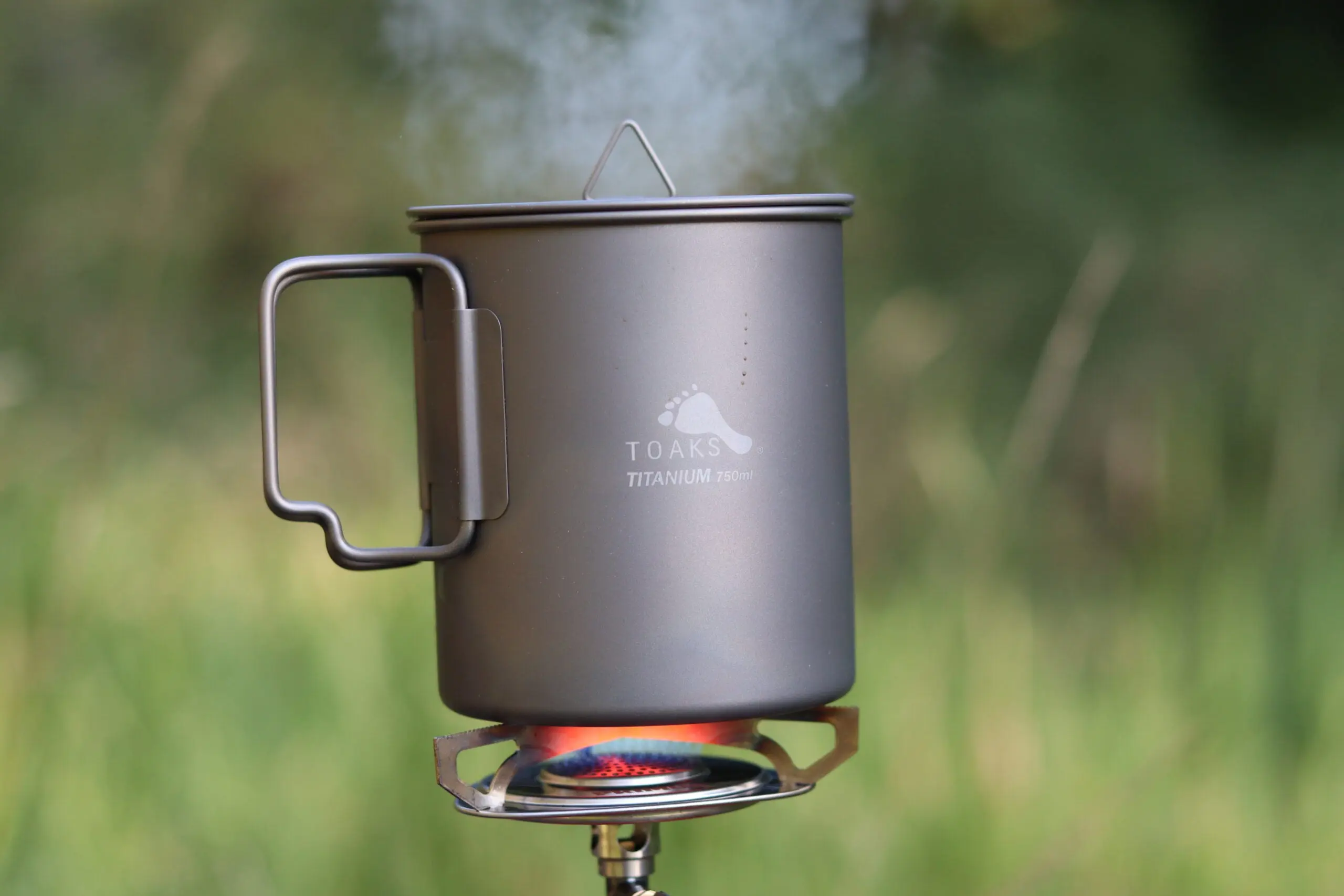
The Toaks 250ml pot is extremely lightweight and perfect for saving weight on camping adventures. Matt Medendorp
Best Backpacking Set: Primus Essential Trails Kit

Specs
Essential Trek Pot 1.0L
Materials: Anodized aluminum, 1.0L fry pan/pot lid works as a skillet or lid
Weight: 9.5 ounces
Dimensions: 4.6 x 5.7 inches
Feeds: 1-2
Spiral pattern on base for heat transfer and additional grip on stove pot supports
Two adjustable and removable handles allow you to cook or transport pots with ease
Essential Trek Pot 0.6L
Materials: Anodized aluminum, 1.0L fry pan/pot lid works as a skillet or lid
Weight: 4.9 ounces
Dimensions: 3.7 x 3.5 inches
Feeds: 1
Spiral pattern on base for heat transfer and additional grip on stove pot supports
Lightweight plastic lid with silicone handles with integrated strainer
Pros
Lightweight and highlight packable
Wears well
Primus stove and gas nest inside pot
Cons
The ceramic frying pan is small
Smaller boil capacity
Handles have no heat protection
I have tried various pots on backpacking trips, and haven’t been happy until I landed on the Primus Essential Trail Kitchen. Built from anodized aluminum, the 0.5 L pot is sleek and durable, swapping a bulky heat exchanger for a spiral pattern on the pot. The lid doubles as a small frying pan, big enough to fry an egg. There isn’t a lot of surface area there, but it increases the versatility of the pot beyond simple rehydration duties.
Best of all, Primus designed this as a nesting system capable of storing their Trail Essentials stove and a 230g gas canister within. This kit includes a combo of their high-performing essential trail stove and trail pot for a pretty screaming deal of $65. They also offer the pot as a standalone or in a larger 1 L size.
It’s worth noting, that while this set offers more versatility than its titanium competitors, it has fewer bells and whistles than other backpacking sets. The pot handles, while cleverly designed to fasten the whole system in place when not in use, don’t insulate from the heat of the stove. And the capacity is small—it will help feed one to two people at most without several rounds to the stove. But that’s a metaphor for backpacking itself: a sacrifice of some small comforts for greater mobility. And I’m never hiking without a buff or bandanna, which serves as my pot holder.

The author reduces black raspberries on his Primus Essential Trail Kit. Matt Medendorp
Best Cast Iron: Lodge Cast Iron Combo Cooker

Specs
Type: 3.2 qt. Dutch oven; lid/frypan
Dimensions: 16.5 x 10.38 x 4.63 inches
Materials: Cast iron
Weight: 12.85 lbs; top 6.46 lbs, deep skillet 6.39 lbs
Pros
Excellent cost-to-functionality ratio
Allows for cooking on the stove or in a fire
Properly taken care of, it’ll last a lifetime
Cons
Heavy (it is cast iron, after all)
Can’t use dutch oven with the lid and the skillet simultaneously
For campers, cast iron’s value is in its practical utility. It is nearly indestructible and excels over the open flames of both camp stoves and firepits—no iron grate needed. It won’t work for every trip—cast irons are too heavy to schlep in your pack and constant water exposure may lead to rust—but perfect for adventures where you aren’t worried about pack weight.
The folks at Lodge have made cast iron pans for over 140 years, and they aren’t showing signs of slowing down. When I worked at Flagstaff Grand Canyon outfitters, we sent dozens of dutch ovens down the river with private boaters floating the Colorado for two-to-six weeks. Durable, high performing, and has the bonus of working well in your home kitchen too. Lodge’s range is stunning, and the options can be overwhelming. We recommend this Lodge Cast Iron Cooker Combo to get you started with a dutch oven and skillet combo.
Best Heirloom Quality: Yeti 12” Cast Iron Skillet Set
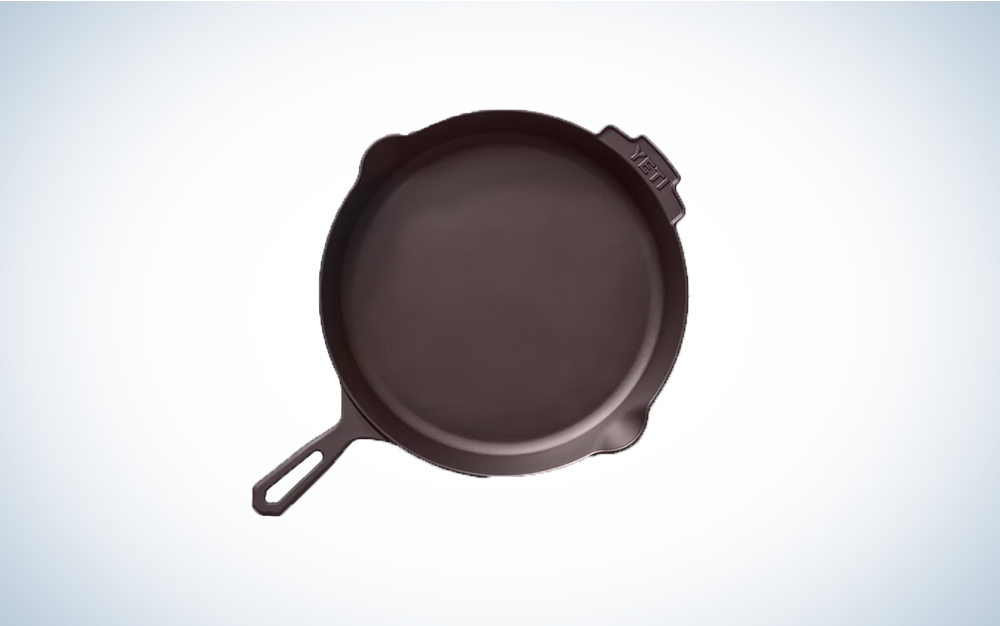
Specs
Width: 13″
Length: 18″
Height: 1.875″
Diameter: 12″
Cooking Surface: 10″
Weight: 6.9 lbs
Pros
Thinner construction allows for more rapid heat transfer
Hand forged for cooking over open fires
Spouts on each side for easier pouring
For a 12” cast iron pan, it’s surprisingly light
Cons
Still heavier than aluminum, steel, and especially titanium
No lid option
Expensive
Yeti worked with Butter Pan Industries to create hand-cast pans that result in a smoother thinner skillet that balances heat beautifully. It’s designed for cooking over an open fire so you can channel your inner Francis Mallaman, but it’ll work equally well on a burner. It comes pre-seasoned and is shipped with a scraper tool and metal ring-rag, which looks like a comically small piece of chainmail but is nonetheless effective for smaller stains.
While this pan functions extraordinarily well in the backcountry, it is also a great choice for the backyard. I use mine on my deck, paired with a cooktop adapter to my Solo stove to sear steaks and make breakfast a little more adventurous. This is a pan you can pass down to your kids, grandkids, and maybe even great-grandkids. And you’ll want to. At a hefty $400 price tag, it isn’t for everyone, but those who make the investment will be pleased.
Best Foldable: Sea to Summit X-Set 32
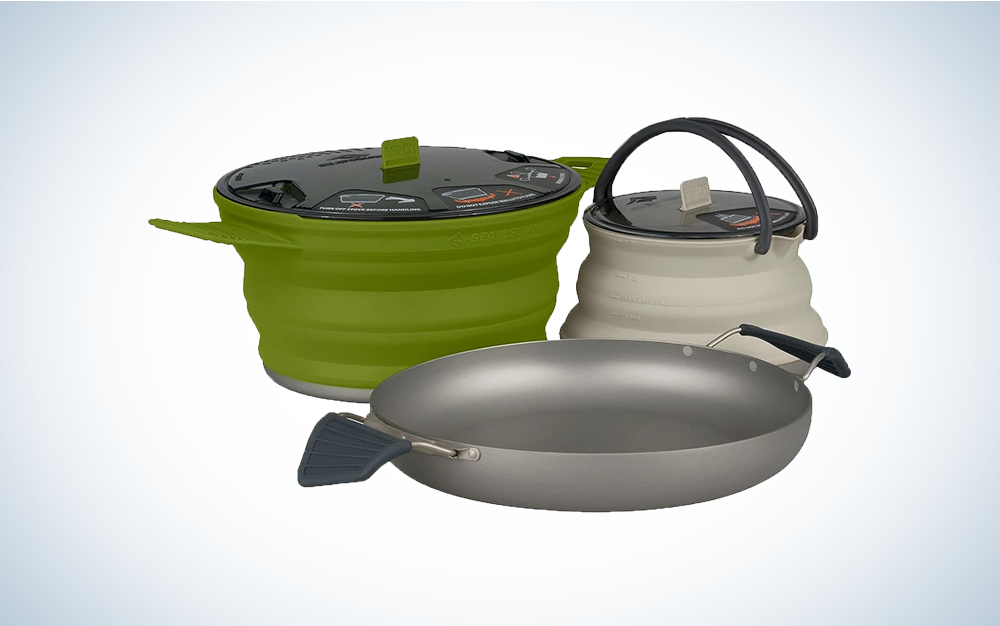
Specs
Materials: Silicone walls and aluminum base
Weight: 29-ounce set
Dimensions: 2.8L X-Pot, 1.3L X-Kettle & 8″ X-Pan
Pros
Packs extraordinarily well
Lightweight
Separate pot and kettle combo allows you to make food/create hot drinks at the same time
Cons
Very specific usage and care guidelines
Lack of durability
Foldable pots and pans may seem like a gimmick or something from a bad 80’s sci-fi novel, but they’re a backcountry tech innovation that saves an incredible amount of space. That space savings comes with a tradeoff: specific rules of engagement around water levels, heat capacity, and the lack of campfire cooking. But for trips where saving space is your ultimate need, foldable cookware is an elegant origami solution.
The designers at Sea to Summit perfected this genre of cookware with their X-32 set. Consisting of three pieces: a 2.8 L pot, a 1.3 L kettle, and an 8-inch aluminum frying pan, the whole set collapses to the size of a frisbee and weighs in at just 27.2 ounces. While the sides are built from food-grade and heat-resistant silicone, the bases are made from aluminum, allowing the pots to take the direct heat of the stove. There are caveats, though—you have to be careful not to let the flames lap up over the side of the aluminum bottom, keep a minimum amount of water in the pots to protect the silicon, and wait at least 30 seconds after the stove is turned off to pick up your cookware. If it seems like a lot to remember, fear not; Sea to Summit has stamped instructions on the bottom of the pot and on the lids to ensure you won’t forget. And speaking of lids, the X pot has a built-in strainer for draining pasta with an integrated pot holder to protect your hands. Not too shabby.
Best on a Budget: GSI Bugaboo Mess Kit
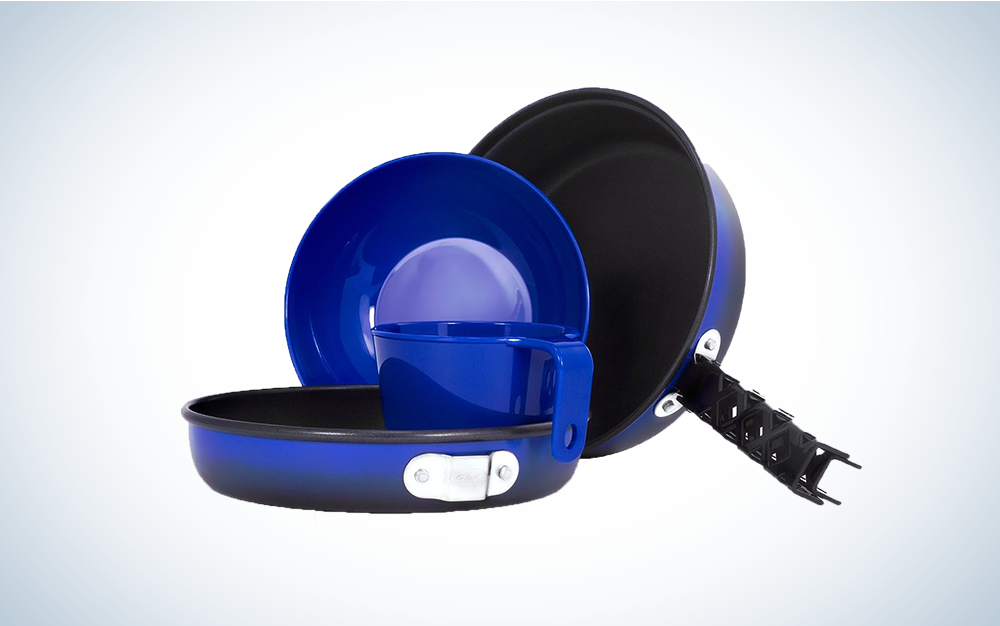
Specs
Materials: Nonstick-coated aluminum/polypropylene
Components: 1 qt. pot; 7.5 in. frypan/lid; 6 in. bowl; 12 fl. oz. cup; pot gripper; mesh bag
Weight: 1 lb. 0.7 oz.
Pros
Nesting Design
The non-stick coating makes clean-up easy
Includes bowl, mug, and pot holder
Cons
Pot has a lower capacity than others on this list
Heavy for an aluminum cook set
Budget camping cookware is a tough needle to thread: pinch too many pennies, and you may end up eating raw pasta on the trail (works for ramen, but not rotini). Enter GSI’s Bugaboo Mess Kit, which is affordable, not cheap—an important distinction. At just under $38 and built from aluminum with a non-stick coating, the set contains a 1-quart pot; a 7.5-inch frypan that doubles as a lid, a 6-inch bowl, a 12-ounce mug, a pot gripper, and a mesh bag to store it all in. It doesn’t reinvent the wheel, but at this price point, that’s not what you’re looking for. It cooks and packs well, and won’t let you down. What more can you ask for?
What to Consider Before Buying Camping Cookware
The type of camping you do is the biggest factor when determining the right set of cookware for your adventure. Once you figure out your pursuit, then you can start to think about these considerations:
Activity
Every pot has its correct application. A dutch oven won’t work for an ultralight rim-to-rim-to-rim backpacking trip in the Grand Canyon, and a single-walled titanium mug will be useless to cook pancakes for a lazy morning of car camping. Carefully consider the priorities and limitations of your trip. Do you need to conserve packing space in your backpack? A foldable pot might be right for you. Do you have multiple dry boxes for a casual float? It might be time to double up on the Cast Iron. Let your activity, and the needs and limitations, dictate what cook set you reach for.
Group Size
This one might seem obvious, but it’s worth noting. Bigger groups will require a bigger capacity and different systems. Solo outings can get away with a minimalist approach. There are workarounds—large groups can split into several smaller cook groups—but everything requires planning ahead. You don’t want to be caught making pasta for 12 in a pot that boils half a liter of water at a time.
Menu
Some people like the convenience of freeze-dried food
in the backcountry. Some prefer to pack a veritable chef’s table of ingredients. The naturalistic inclined might want to forage along the way. Every trip necessitates a meal plan, and each meal plan comes with its own cooking needs. Consider whether your menu requires any sauteing or non-stick cook options. Do you just need to boil water? How flexible and trusting do you want to be with the self-appointed mushroom expert of the group? All of these factors will help determine what your final choice is.
FAQs
Q: What size cookware is best for backpacking?
While this will depend on your group size and meal choices, generally, pots in the 0.5L-1 L capacity and pans 8 inches or less are ideal for backpacking trips. Remember that weight and space are the limiting factors when loading a backpack. For groups larger than four, it’s smart to divide into smaller cook groups which splits the packing burden and builds in some redundancy in case of a stove or pot disaster.
Q: How much does camping cookware cost?
Like everything, there’s a wide range of available costs. On this list, you’ll find everything from a titanium pot for $35 to a cast iron skillet for $400. But in general, a camping cookware set will run anywhere from $40 to $120 depending on materials, size, and number of included pieces.
Q: Are camp stoves safe?
Gone are the days of leaky, gas-pumped contraptions that require an engineering degree to get started. These days, camp stoves have more in common with your backyard grill than complicated contraptions. Caution is always advised when using combustible gas and open flame, but if you’re comfortable starting your Weber, then you’ll be comfortable firing up an isobutane gas canister.
Best Camping Cookware: Final Thoughts
Best Overall: Fry Bake Alpine Set
Best Titanium: Toaks Titanium 750ml Pot with Handle
Best Backpacking Set: Primus Essential Trails Kit
Best Cast Iron: Lodge Cast Iron Combo Cooker
Best Heirloom Quality: Yeti 12” Cast Iron Skillet Set
Best Foldable: Sea to Summit X-Set 32
Best on a Budget: GSI Bugaboo Mess Kit
While the perfect set of camp cookware will vary widely by activity and menu choice, it’s hard to think of a situation where the Banks Fry-Bake will let you down. Lightweight, versatile, and durable enough to take on years of repeated use in rugged NOLS courses, buying a Fry-Bake is a one-time investment in a lifetime of camping culinary excellence.
Why Trust Us
For more than 125 years, Field & Stream has been providing readers with honest and authentic coverage of outdoor gear. Our writers and editors eat, sleep, and breathe the outdoors, and that passion comes through in our product reviews. You can count on F&S to keep you up to date on the best new gear. And when we write about a product—whether it’s a bass lure or a backpack—we cover the good and the bad, so you know exactly what to expect before you decide to make a purchase.





